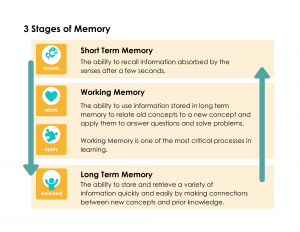In this post, we help you understand working memory challenges. First, we’ll define the three stages of memory. Second, we are going to share what to look for in reading, math, writing, and social-emotional learning to identify students who may have working memory challenges.
3 Stages of Memory To Read the Word “cat”
Let’s look at what goes on in a student’s memory the first time he reads the word “cat”.
Short Term Memory
Short term memory is the ability to recall information absorbed by the senses after a few seconds. Students use short-term memory to absorb information. Short term memory deficits lead to difficulty copying information, transferring it, or writing from dictation. The student uses short term memory to absorb the letters c, a, and t so he can recall them when he is working out the problem of reading the word cat.
Long Term Memory
I once took a course with Dr. Thomas Hehir from Harvard Graduate School Of Education. I remember one quote in particular. He said, “If you do not influence what is in a student’s long term memory, you have not taught him anything.” Long term memory is the ability to store and retrieve a variety of information quickly and easily by making connections between new concepts and prior knowledge. When reading “cat”, the student uses long term memory to retrieve prior knowledge about the letters c, a, and t. In prior lessons, the student learned the names of the letters and the sounds they make. He will use this information in his working memory in order to read the word.

Working Memory
Working memory is the ability to use information stored in long term memory to relate old concepts to a new concept. Students have an awareness when they are using working memory to apply concepts to answer questions and solve problems. Working Memory is one of the most critical processes in learning.
Here’s how working memory processes reading the word “cat”. Working memory says,
- This is the letter c. It makes the sound /k/ when it comes before an a. Hold that.
- Next is the letter a. It makes the sound /a/ in the middle of a CVC word. Hold that.
- This is the letter t. It makes the sound /t/. Hold that.
- Now go back and recall all three sounds in sequence /k/ /a/ /t/.
- Blend them together. /kat/
- Say cat.
If “cat” is a familiar word, long term memory retrieves an association with the word cat in the form of an image or experience with cats. It gleans the correct meaning of the word cat and helps to solidify the symbols and sounds for “cat” in long term memory.
What gets missed
Of course, with practice, the brain does this so quickly that we barely notice it. However, what happens in working memory leaves some opportunities for missteps. To read the word cat the student must use working memory to:
- Recall the correct letters (symbols).
- Connect the right sounds.
- Remember the rules (such as hard c and short a)
- Hold prior letter sounds while processing a new one.
- Resequence all the letter sounds.
- Blend all the letter sounds quickly and accurately.
Let’s face it. There’s a lot going on in there! When teaching students to read, I had to learn how to find the misstep and correct that misstep. I had to ask, “Is this a letter recognition problem? Is it a rule problem? Is it a sequence problem?” Like any skill, it took professional learning and experience to become proficient in analyzing these missteps. If you are a special educator, you are likely to have more experience teaching students with working memory challenges. However, you don’t have to be a master teacher to identify students who could need help. Read on to learn what to look for.
Which Students May Have Working Memory Challenges?
During your reading lesson, students with working memory challenges are likely to have difficulty:
- recalling letter to sound correspondences.
- reading fluently due to weak decoding and sight word retrieval
- using context clues.
- retelling/sequencing stories, inferencing, and summarizing.
- remembering academic vocabulary
During your math lesson, they are likely to have difficulty:
- solving multistep problems
- using mental math
- following procedural steps
During your writing lesson, they are likely to have difficulty:
- staying on track
- organizing and sequencing ideas
- remembering and applying structure
Working Memory and Social-Emotional Learning
When students have challenges with working memory, it is not unusual to hear teachers say they are inattentive and lacking in concentration rather than recognizing their memory difficulties. Other descriptions include:
- difficulty organizing and completing tasks,
- trouble concentrating
- when given 3 step directions, she only remembers what is first or last.’
- short attention span
- is always asking for help
- can’t stay on task
- has trouble finishing work
If you find yourself describing a student this way, it could be a working memory challenge that is causing the problem.



